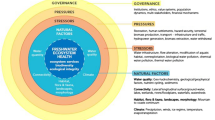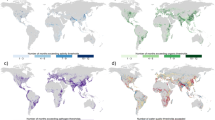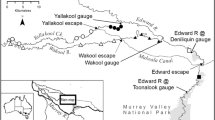Abstract
Freshwater resources in the River Thames basin in southern UK are faced with combined pressures of future population growth and climate change. River basin managers are seeking increasingly innovative methods to meet water demand whilst at the same time maintaining ecological status. Using a river network hydrochemical model modified to account for possible future climate and population, the paper assesses the impact on downstream water quality of changing the location of a major point of abstraction serving the city of Oxford. The rationale behind the hypothetical change, although entailing an increase in energy costs and capital expenditure, was that flows would be maintained along a sensitive stretch of river. Model results at a location a further 23 km downstream suggested that better water quality would arise from this change. The predicted improvements included a decrease in the annual frequency of low DO concentrations (<6 mg L−1) from 8–9 days to 2–3 days and a decrease in 90th percentile (summer) temperatures of 0.6 °C. It is believed these improvements would primarily be attributable to shortening of river residence time which curtails accelerated phytoplankton growth. The overall conclusion, of relevance both for the Thames basin and elsewhere, is that water quality in a river network can be surprisingly sensitive to the location of abstractions. Changing the location of abstractions should be considered as part of a suite of measures available to river basin managers when making plans to meet future water demand.
Similar content being viewed by others
Avoid common mistakes on your manuscript.
1 Introduction
Across the globe, freshwater resources are increasingly being threatened due to population growth and changes in climate. Likely depletion of water resources will be exacerbated by increased pollution loads and treatment costs (Wen et al. 2017). As well as potentially failing to satisfy human needs, decreasing flows/river levels have adverse impacts on aquatic habitats and biodiversity (Laize et al. 2013). The principle of environmental flows is becoming increasingly embedded in management planning and acknowledges that water abstraction must be constrained where possible such that river ecosystems are not impaired (Acreman and Ferguson 2010). Matching water availability under conditions of escalating demand is increasingly problematic. Identifying suitable combinations of investment strategies for addressing water scarcity in ways that protect ecosystems, in addition to providing sufficient supply, is a common challenge throughout the world (Vörösmarty et al. 2010). Meeting this challenge involves complex socio-economic considerations for which analysis using dynamic models can provide valuable insights (Dadson et al. 2017).
The Thames river basin (southern UK) illustrates many contemporary issues, facing a likely increase in population (12% for England from 2017 to 2041: ONS 2017) alongside increasing climatic stress. An increase in flood frequency and magnitude brought about by climate drivers is very possible (Bell et al. 2012). At the other extreme, a future downward trend in low flows is likely (Prudhomme et al. 2012). Projections suggest water resources will be threatened unless water is managed more efficiently and sustainably in domestic and industrial sectors (Hutchins et al. 2016b). Allied to this it is expected that the increasing river residence time arising from lower baseflow will trigger longer and more severe eutrophication episodes (Bowes et al. 2012; Hutchins et al. 2016a). Water companies are seeking concerted and innovative ways of balancing future water supply with environmental requirements. Thames Water (2016) are evaluating a suite of measures such as additional reservoir capacity, water transfers, waste-water re-use and desalinisation to meet the likely shortfall. Equally, regulators are working towards coherence in water quality and water resource planning around climate adaptation.
The present paper seeks to show how an alternative configuration of water infrastructure (abstraction and effluent locations) can, in the right circumstances, help protect river water quality whilst minimising energy usage and capital expenditure. Specifically the alternative scenario we consider maintains river flows in a stretch of the Thames passing through Oxford where rapid increases in chlorophyll concentrations are observed in most years (Bowes et al. 2012). To do this we use QUESTOR, a water flow and quality model developed for the upper Thames (Hutchins et al. 2016a).
2 Method
2.1 Study Area
The Thames, a river of total length 354 km has the largest catchment area wholly in England (Fig. 1). In the basin, 40% of water supply comes from groundwater (predominantly Oolitic Limestone and Cretaceous Chalk aquifers). In terms of the water quality of groundwater bodies, 47 and 38% have poor quantitative and chemical status respectively (Environment Agency 2016). Whilst the majority of surface water bodies have good chemical status, only a small minority (<10%) meet good ecological status.
The upper Thames (catchment area at the town of Wallingford 3445 km2) is the focus of the present study. The upper basin receives mean annual rainfall of 744 mm (Marsh and Hannaford 2008). It is predominantly rural despite being highly populous (the dominant land classification being arable (45%), with only 6% urban/suburban). Surface water supply is primarily from Farmoor Reservoir (with an abstraction from the river 2.9 km upstream of Site 2 on Fig. 1), which supplies Swindon and Oxford amongst other population centres. The Farmoor abstraction of 1.62 m3 s−1 effectively reduces mean flow at Wallingford (51 km downstream) by about 5%. In return, the Sewage Treatment Works (STW) effluent at Sandford downstream of Oxford contributes 0.47 m3 s−1. At Wallingford, ample nutrient loads sustain phytoplankton; nitrate-N and total phosphorus in recent years always exceeding 1.4 and 0.09 mgL−1 respectively (Bowes et al. 2012).
2.2 Model Description
The QUESTOR model application (Hutchins et al. 2016a) focuses on a stretch representing 126.4 km of river channel network (comprising the River Cherwell and River Thame tributaries and the main Thames) split into 41 reaches. The model is fed by 23 tributaries and 7 major STWs, and accounts for 2 abstractions and 22 weirs. The main determinands simulated are chlorophyll-a (a proxy for phytoplankton biomass), biochemical oxygen demand (BOD), dissolved oxygen (DO), inorganic phosphorus (equating to SRP, the Soluble Reactive Phosphorus fraction), organic phosphorus, nitrate, particulate organic nitrogen, ammonium, pH, temperature, flow and photosynthetically-active radiation in the water column. The processes represented are aeration, BOD decay, deamination, nitrification, denitrification, benthic oxygen demand, BOD sedimentation, phosphorus mineralisation, in conjunction with a biological sub-model of phytoplankton (comprising growth, respiration and death), which includes nutrient uptake and release. A mixed phytoplankton population is assumed. The equations describing DO, BOD, temperature and chlorophyll-a are given (Online Resource 1). Values of the Nash-Sutcliffe efficiency goodness-of-fit statistic for model performance at Wallingford (Site 4) for a two-year period of testing against weekly data were 0.81, 0.77, 0.13 and 0.22 for temperature, nitrate, SRP and chlorophyll-a respectively. Further model performance statistics are shown below (Table 1) and discussed in detail by Hutchins et al. (2016a). Overestimation in SRP is predominantly attributed to especially low flows in the Thame tributary, conditions known to promote attenuation of phosphorus in bed sediments, which is not represented in the model. Mismatches of chlorophyll time series primarily arise through assuming a constant grazing rate for phytoplankton loss. Data are insufficient to represent grazing in the model in more detail.
2.3 Model Applications
The model was run for a 4 year period, based on 2009–12 weather patterns, but with modifications made to account for changes which may occur under future climate and population growth. Input conditions in tributaries and other influences (e.g. for N and P concentrations) were defined by taking present day monthly mean concentrations. Thereby it was assumed that agricultural nutrient management practice and levels of sewage treatment would remain unchanged. Daily radiation data were provided from Little Rissington near the River Windrush in Gloucestershire (NGR 4299 2107) by the British Atmospheric Data Centre (MIDAS Landsat Data). To account for effects of riparian shading, direct radiation reaching the water surface was reduced by 19% under conditions of full leaf, this reduction equates to riparian canopy occupancy of 27%. Waylett et al. (2013) provide further details of the procedure for quantifying shading. Representations of effects of future climate on river flows and water temperature were guided by modelling of hydroclimatology (Prudhomme et al. 2012) as summarised for the Thames by Hutchins et al. (2016a). Focus was made on best capturing summer conditions when river water quality is most vulnerable to deterioration. To represent population growth, the UK Office for National Statistics previously estimated a 16% growth from the period covered by QUESTOR model testing up to 2035. To allow for these projections the following modifications to all present-day daily values of model input were made:
-
Flow: scalar multiplier ×0.8
-
Water temperature: change factor + 3 °C
-
Urbanisation: scalar multiplier ×1.16 (this represents a combination of population growth and changes in water use efficiency)
To meet the objectives of the paper a pair of model applications was undertaken to represent the following scenarios (Fig. 2):
-
1.
A system with the same configuration for abstraction as occurs presently (i.e. abstraction from the River Thames upstream of Farmoor Reservoir). “Present Configuration (PC)”
-
2.
A scenario whereby the volume of water currently abstracted upstream of Farmoor is abstracted from the river further downstream near the town of Abingdon instead (Site 3) and piped back to Farmoor for storage and distribution. “Alternative Configuration (AC)”. This Alternative Configuration (AC) scenario would avoid the reduced flows for the 20 km stretch through Oxford, thereby reducing residence times.
3 Results and Discussion
Whilst simulated flows will differ between the scenarios from reach to reach between Sites 2 and 3, at Wallingford (Site 4) they are identical for the two configurations. In contrast, a set of water quality indicators, representative of summer low flow periods when conditions are most vulnerable, are substantially better under the alternative configuration (Table 2). These indicators are assessed in the context of regulatory standards. UKTAG (2008) cite the Freshwater Fish Directive values for (i) 98th percentile water temperature of 21.5 °C for salmonids and 28 °C for cyprinids, (ii) 10th percentile DO set at 6 mg L−1 (iii) a 90th percentile BOD value of 4 mg L−1 is cited as a good status target for salmonid rivers. Standards related to phytoplankton biomass are absent in the UK. However in the USA, Dodds et al. (1998) cite summer median chlorophyll-a concentrations above 0.03 mg L−1 as being indicative of eutrophic conditions.
Fluctuating and periodically low DO occurs throughout the summer when river flows are low (Fig. 3). These did not occur in the wet summer conditions of 2012. The number of days with low DO are more frequent under PC than AC. The key difference for DO and other indicators of water quality is that in the “Present Configuration”, when conditions become drier in the summer, the flow rate becomes low in the 20 km stretch of the Thames passing through Oxford (between Farmoor and Sandford where Oxford sewage effluent returns to the Thames). These low flows provide potentially longer residence times and therefore viable conditions for phytoplankton blooms to develop and then crash due to nutrient limitation. Crashes generate BOD and remove DO. Lower flows and longer residence times also lead to higher water temperatures which in turn can further lower the DO. In the “Alternative Configuration” flow levels are maintained through the stretch between Farmoor and Sandford. Consequently accelerated eutrophication and its impacts are less likely to occur, and the river will warm up to a lesser extent.
It is apparent that the differences in DO between the two configurations by no means wholly arise from differences in water temperature (Fig. 4). Especially in early-midsummer these differences are driven by eutrophication impacts, corresponding more strongly to differences in chlorophyll-a and BOD.
4 Wider Implications
Abstracting from Abingdon instead of upstream of Farmoor Reservoir (for water supply to urban areas such as Oxford) may not initially seem rational from the perspective of economic and energy costs, yet the water quality downstream is predicted to be substantially better. Of particular note is the projected reduction in the incidence of DO falling below the ecological threshold of 6 mg L−1. The incidence of poor water quality is attributable to periods where flows are low in part of the river network, in this case through Oxford. The finding, that flow levels can have direct water quality and ecological implications, is of direct relevance for the pinpointing of environmental flow requirements.
Our results, identifying considerable implications arising from moving a major abstraction point, merit further discussion. Water supply in the Thames has some inherent vulnerability to climate pressures, as the storage space quoted by Thames Water (2016) is only of the order of 100 days. Of the options available to meet future shortfall, raw water transfers from wetter regions of the country have been put forward. Whilst those water transfers deemed plausible (Thames Water 2016) have a deployable output of approximately 3 m3 s−1 and could greatly improve water quality as well as meeting shortfalls, adverse effects are likely. Canal or pipeline construction is complex. Transfers may introduce invasive species and will impair the natural flow regime in the upper Thames. In addition, impacts on the source water body may be detrimental.
An analysis of the differences in capital expenditure and operating costs between raw water transfer options and a re-configuration of reservoir storage outlined above is out of the scope of this paper. Nevertheless, some broad differences are noteworthy. Piping and treating Thames river water from Abingdon, which is more polluted than river water at Farmoor, would clearly incur greater overall costs than that entailed presently. In comparison however, a potential transfer from the adjacent River Severn basin would potentially be much more costly, needing to cover a far longer distance (approximately 4 times as far) and much hillier terrain (approximately 10 times the increase in altitude).
It seems that the option addressed here should be considered alongside other major water supply options when making plans to meet future water demand. We argue that such considerations should be built into strategic appraisals by river basin managers of the various options available. This is important both in basins such as the Thames, but not least in those regions throughout the world where urbanisation is predicted to proceed much more rapidly and where infrastructure is currently minimal or absent.
References
Acreman MC, Ferguson AJD (2010) Environmental flows and the European Water Framework Directive. Freshw Biol 55:32–48
Bell VA, Kay AL, Cole SJ, Jones RG, Moore RJ, Reynard NS (2012) How might climate change affect river flows across the Thames Basin? An area-wide analysis using the UKCP09 Regional Climate Model ensemble. J Hydrol 442-443:89–104
Bowes MJ, Gozzard E, Johnson AC, Scarlett PM, Roberts C, Read DS, Armstrong LK, Harman SA, Wickham HD (2012) Spatial and temporal changes in chlorophyll-a concentrations in the River Thames basin, UK: are phosphorus concentrations beginning to limit phytoplankton biomass? Sci Total Environ 426:45–55
Dadson S, Hall JW, Garrick D, Sadoff C, Whittington D, Grey D (2017) Water security, risk and economic growth: insights from a dynamical systems model. Water Resour Res 53:6425–6438
Dodds WK, Jones JR, Welch EB (1998) Suggested classification of stream trophic state: distributions of temperate stream types by chlorophyll, total nitrogen and phosphorus. Water Res 32:1455–1462
Environment Agency (2016) Thames river basin district River Basin Management Plan. Part 1. https://www.gov.uk/government/uploads/system/uploads/attachment_data/file/500548/Thames_RBD_Part_1_river_basin_management_plan.pdf. Accessed 26 Feb 2018
Hutchins MG, Williams RJ, Prudhomme C, Bowes MJ, Brown HE, Waylett AJ, Loewenthal M (2016a) Projections of future deterioration in UK river quality are hampered by climatic uncertainty under extreme conditions. Hydrol Sci J 61:2818–2833
Hutchins MG, Abesser C, Prudhomme C, Elliott JA, Bloomfield JP, Mansour MM, Hitt OE (2016b) Combined impacts of future land-use and climate stressors on water resources and quality in groundwater and surface waterbodies of the upper Thames river basin, UK, Science of the Total Environment (in press)
Laize CLR, Acreman MC, Schneider C, Dunbar MJ, Houghton-Carr HA, Florke M, Hannah DM (2013) Projected flow alteration and ecological risk for pan-European rivers. River Res Appl 30:299–314
Marsh TJ, Hannaford J (2008) UK hydrometric register. Hydrological data UK series. Centre for Ecology and Hydrology, Wallingford
ONS (2017) National population projections: 2016-based statistical bulletin. Office for National Statistics, UK
Prudhomme C, Haxton T, Crooks S, Jackson C, Barkwith A, Williamson J, Kelvin J, Mackay J, Wang L, Young A, Watts G (2012) Future Flows Hydrology: an ensemble of daily river flow and monthly groundwater levels for use for climate change impact assessment across Great Britain. Eart Syst Sci Data Discuss 5:1159–1178
Thames Water (2016) Draft drought plan October 2016 Accessed at https://corporate.thameswater.co.uk/About-us/Our-strategies-and-plans/Our-drought-plan/Drought-plan-update-2017. Accessed 3 Dec 2017
UKTAG (2008) Environmental standards and conditions (Phase 1). UK technical advisory group of the water framework directive final report April 2008
Vörösmarty CJ, McIntyre PB, Gessner MO, Dudgeon D, Prusevich A, Green P, Glidden S, Bunn SE, Sullivan CA, Liermann CR, Davies PM (2010) Global threats to human water security and river biodiversity. Nature 467:555–561
Waylett AJ, Hutchins MG, Johnson AC, Bowes MJ, Loewenthal M (2013) Physico-chemical factors alone cannot simulate phytoplankton behaviour in a lowland river. J Hydrol 497:223–233
Wen Y, Schoups G, van de Giesen N (2017) Organic pollution of rivers: combined threats of urbanization, livestock farming and global climate change. Sci Rep 7:43289
Acknowledgements
We acknowledge support from NERC-CEH Pollution & Environmental Risk and Water Resources Science Areas. The model was supplied with and tested against hydrological data from the National River Flow Archive. Solar radiation data were accessed from British Atmospheric Data Centre.
Author information
Authors and Affiliations
Corresponding author
Electronic supplementary material
ESM 1
(DOCX 22 kb)
Rights and permissions
About this article
Cite this article
Hutchins, M.G., Bowes, M.J. Balancing Water Demand Needs with Protection of River Water Quality by Minimising Stream Residence Time: an Example from the Thames, UK. Water Resour Manage 32, 2561–2568 (2018). https://doi.org/10.1007/s11269-018-1946-0
Received:
Accepted:
Published:
Issue Date:
DOI: https://doi.org/10.1007/s11269-018-1946-0








